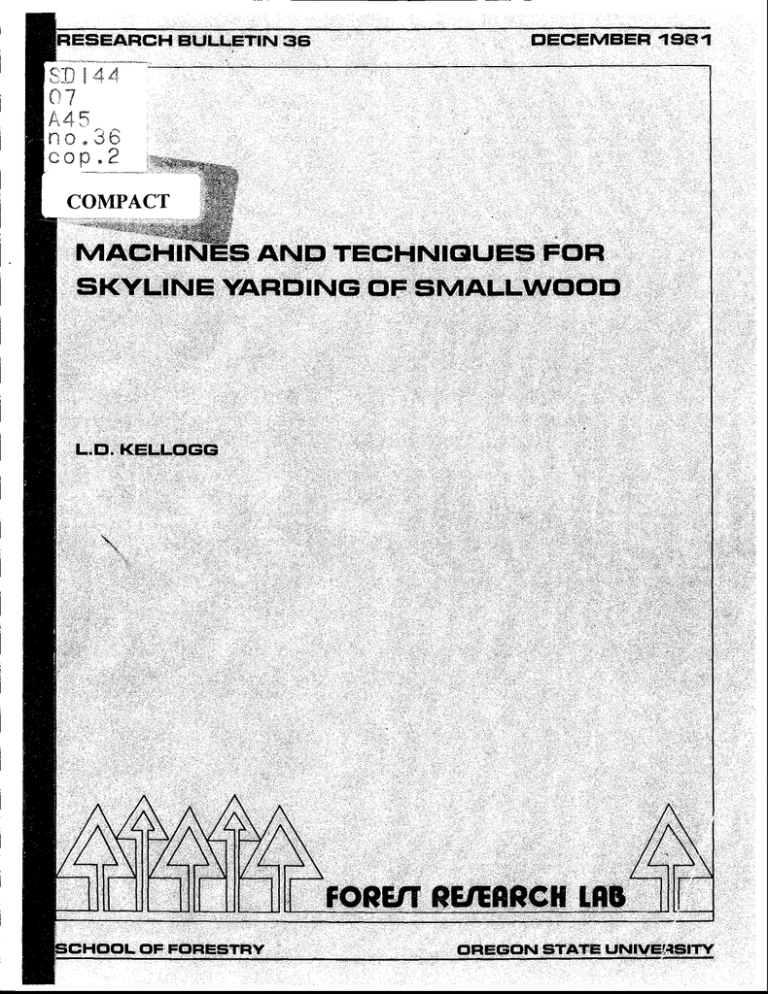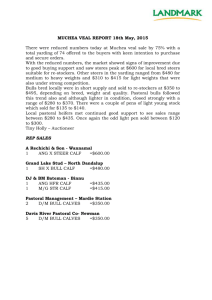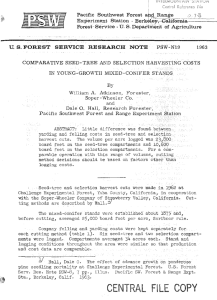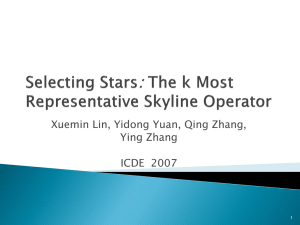m MACHIN S AND TECHNIQUES FOR SKYLINE YARDING OF SMALLWOOD ARCH LAS
advertisement

mRESEARCH BULLETIN 36 DECEMBER 1611 COMPACT MACHIN S AND TECHNIQUES FOR SKYLINE YARDING OF SMALLWOOD L.D. KELLOGG L__j CHOOL OF FORESTRY FOR R ARCH LAS i[ OREGON STATE UNIVERSITY Since 1941, the Forest Research Laboratory--part of the School of Forestry at Oregon State University in Corvallis-has been studying forests and why they are like they are. A staff of more than 50 scientists conducts research to provide information for wise public and private decisions on managing and using Oregon's forest resources and operating its wood-using industries. Because of this research, Oregon's forests now. yield more in the way of wood products, water, forage, wildlife, and recreation. Wood products are harvested, processed, and used more efficiently. Employment, productivity, and profitability in industries dependent on forests also have been strengthened. And this research has helped Oregon to maintain a quality environment for its people. right In the Laboratory's facilities on the -campus. But field experiments in Much research is done forest genetics, young-growth management, forest harvesting methods, and- reforestation are conducted on 13,000 acres of School forests adjacent -to the campus and on lands of public and private cooperating agencies throughout the Pacific Northwest. hydrology, With these the publications, Forest The Author Loren Kellogg is an instructor, Department of Forest Engineering, Oregon State University, Corvallis. Disclaimer The mention -of trade names or comnercial products in this publication does not constitute endorsement or recommendation for use. To Order Copies Copies of this -and other Forest Research Laboratory -publications are available from: Forest Researci-.Laboratory School of Forestry Oregon_ State University Corvallis, Oregon 97331 - Please include -author(s), number if -known. title, and publications Research Laboratory supplies the results of its research to forest -land owners and managers, to manufacturers and users of forest _ment and industry, As a research bulletin, this publication is one of series that experiment or basis. a products, to leaders of governand to the general public. describes a completed lists publications on study a or specific As an- affirmative action institution that complies with Section 504 of' the Rehabilitation Act of 1973, Oregon State University -supports equal educational and age, -sex, employment opportunity -without regard to race, creed, national status, or religion. origin, -handicap, marital CONTENTS 2 ABSTRACT 2 INTRODUCTION 2 USED YAROERS WITH A LOW INITIAL COST 3 SKYLINE CARRIAGES 4 THINNING IN YOUNG, DENSE STANDS 6 NEW YARDERS WITH A HIGH INITIAL COST 6 MULTISPAN YARDING 7 PREBUNCHING AND SWINGING 8 NEW YARDERS WITH A LOW INITIAL COST 12 SAFETY REGULATIONS 12 SUMMARY - 13 REFERENCES CITED ORIGINALLY APPEARED IN: Fifth Northwest Skyline Logging the by 1981, sponsored Symposium, University of Washington, Seattle. 4 2 ABSTRACT on skyline machines and techniques currently available for yarding smallwood is reviewed. Three categories of machines are discussed: used yarders (with a low initial cost) adaptable to Research smaliwood, new and versatile yarders (with initial cost) manufactured in the United States, and new, foreign-built yarders (with a low initial cost) specifically developed for smallwood. Used, inexpensive yarders can be a viable option for yarding smallwood, but carriage selection and timber size are important cona high Prebunching small logs with a separate, low-cost system can increase yarding production and lower harvesting siderations. costs incurred with expensive new yarders. Proper determination of crew size and equipment balance can produce more costeffective use of new, low-cost yarders. Because smallwood logging will increase in the Pacific Northwest as log diameter continues to drop, research and additional evaluation to improve the effectiveness of machines and techniques is essential. INTRODUCTION many loggers smallwood, where tree Today, height (dbh) averages and logs average less are working in diameter at breast less than 20 inches than 17 cubic feet. Trees of this size will be typical of our future forests, whose average tree diameter is predicted to continually decline (Tedder 1979). Much of the smaliwood yarding in the Pacific Northwest is in thinning operations designed to recover part of the timber value early and stimulate residual tree growth. Many pri- vate companies already are regularly harvesting timber stands less than 70 years old, and others will soon follow. In the future, the acreage thinned annually in Region 6 of the U.S. equal the acreage cut (Binkley 1980). Forest Service will in old-growth timber yarding techniques operators (Aulerich 1975, (Kellogg 1980b). Several that techniques developed during smaliwood to forest aid evaluation in have logging the systems managers and and successfully applied Innovative industry. been loggers, land managers, and equipment manufacturers has helped produce new systems and techniques for handling smallwood. thinking of for the This bulletin reviews options machines and techniques used in yarding Although smallwood with the skylines. focus is on thinning, the discussion also to of smallwood applies other types yarding, such as hardwood clearcutting and residue yarding. the early 1970s, researchers at Oregon State University (OSU) began evaluating In USED YARDERS WITH A LOW INITIAL COST two or three drums and towers less than 50 Schield-Bantam mobile yarder, and numerous Because the initial "home-built° yarders. feet high have been used for yarding small fixed Several logging and small, used yarders with corners in larger units, with small logs. They the Skagit Si series, various converted to yarders, the units, clearcuts include cranes mobile, price discouraging profit margin of to is equipment can be new operators whose smallwood often narrow, one alter- native is to adapt used machines with a relatively low (less than $100,000) initi 3 tial price tions. to logging smallwood opera- Carriage selection and timber size important such yarders. are considerations when using SKYLINE CARRIAGES thinning, the carriage should be able remain one the in location during lateral yarding cycle to reduce hangups Christy and lessen residual stem damage. For to and Maki in Company Christy recently modified slackpulling mechanical Idaho) (Orofino, for carriage This (Fig. 2). uses a carriage stop modification still and functions like the gravity carriage. The altered carriage has two cams: one The has that and another the mainline, releases A mechanical slackpulling. for allows and outhaul for is used line haulback The haulback is joined by a slackpulling. shay swivel to the mainline in front of the toward side on the carriage the line haulback on the A ball yarder. allows this line to pull the carriage out without pulling slack until the carriage When the the stop. into locked is carriages are commonly used with operations when thinning a can be carriage-return system used, thereby eliminating the need for haulback line (Fig. 1). For each turn, held in one location on the carriage is the skyline with a stop device that clamps The mainline is pulled by to the skyline. hand through the carriage. The carriage is released from the stop when a ferrule near the end of the mainline snaps into The carriage stop is the carriage lock. the moved along skyline manually by lowering the skyline and releasing the clamp. yarders gravity that specifically controls the locking of carriage stop and the the carriage to its SKYLINE SHEAVE CARRIAGE STOP SLACKPULLING DISTANCE FIGURE 2. VIEW FROM INSIDE THE FRAMEIMORK CF A CHRISTY MECHANICAL FOR MODIFIED CARRIAGE CO., CHRISTY OF (COURTESY SLACKPULLING OROFINO, IDAHO). MAINLINE FIGURE I. YARDING LAYOUT WITH MAKI CARRIAGE (FROM KELLOGG 1980). carriage is at the stop, both cams are in a position to release the mainline and allow the haulback to pull The slack. modified Christy carriage can be rigged for mechanical slackpulling during downhill or uphill yarding on gentle slopes when a haulback is needed; when a haulback is unnecessary, it can be rigged for hand slackpulling. Preliminary results (L. D. Kellogg, unpublished data) from a study at OSU with the modified Christy carriage during summer 1980 showed that production rates for uphill yarding with hand slackpulling were similar to those for downhill yarding with mechanical slackpulling. The only problems encountered with the carriage were delays from line wrapping between the mainline and haulback lines, a problem more severe with uphill than downhill yarding. Lines wrapped directly in front of the carriage during uphill yarding, causing difficult slackpulling; during downhill yarding, lines wrapped away from the carriage and closer to the shay swivel so that slackpulling was unimpeded. TABLE 1. CONDITIONS FOR THE SKAGIT SJ-2 YARDER STUDY (GABRIELLI 1980). Average stand age (years) 33 (inches) Between 1.5 and 6 inches Over 6 inches dbh and 17 feet high (merchantable trees) Average dbh 5.7 8.3 Trees per acre before thinning Between 1.5 and 6 inches dbh Merchantable Volume per (cubic 1,091 483 trees acre before thinning feet)a 5,250 Merchantable trees per acre after thinning 289 Average log size (cubic feet) 7.5 Average corridor length (feet) 330 (range: 0-750) Average lateral yarding distance (feet) THINNING IN YOUNG, DENSE STANDS Intensive management of young stands requires harvest of closely spaced trees 5 to 8 inches dbh. It is important to examine timber harvesting costs associated with these smaller logs to determine what tree sizes and stand densities can be commercially thinned with a skyline system at a profit. To examine this, during summer 1979, Kellogg and Gabrielli (Gabrielli 1980) selected a used Skagit SJ-2 yarder, whose price and labor cost were low. The SJ-2 is a mobile yarder with a rubber-tired undercarriage, a 40-foot-high swing boom, 700 feet of 5/8-inch skyline, and 1,200 feet of 1/2-inch mainline. Three different techniques for hooking logs were evaluated: use of three chokers initial (control), use of six chokers (close to payload capacity for this specific the logging unit), and presetting ring chokers and logging conditions in Table I. a for chokers with toggle. the study Stand and are given 44 (range: 0-190) a1 cubic foot = 3.42 board feet. harvesting costs are summarized in yarding 2. As expected, the Table portion--at 50 percent of total harvest Use of six cost--was the most expensive. chokers was the most productive technique. Use of three chokers (the control) and Total presetting chokers were equally effective at 450 feet but, yarding distances, more productive. at greater presetting skyline chokers was The second most costly item--at 34 percent felling and harvest cost--was of total trees were premarked The cutoperation. paid on an hourly basis, Residual bucking. before the felling ters, who were 5 TABLE 2. TOTAL HARVESTING COSTS (1980 DOLLARS) FOR THE SKAGIT SJ-2 YARDER STUDY. Percent Cost per thousand board feeta Operation Moving equipment in and out $ 13.07 5 76.42 34 113.18 50 Felling and bucking Skyline yarding of total Loading 10.08 11 Hauling 15.14 Total $227.90 100 aCubic volume was converted to board feet so that costs could be determined on the basis of board-foot mill prices. had prior experience in thinnings but not The cutting in small, dense stands. operation was difficult and slow; average production per cutter was 9.71 logs per Much hour. maneuvering of the hangups time was spent in to the ground and moving about in the stand. third most costly item--at II percent--was loading and hauling. Loading The was The done from cold decks after yarding. production rate, average yarding resulting overall time for loading a truck was 1.5 hours. During summer 1979, sawlog mill prices per thousand board feet were between $310 and $285 for Douglas-fir and $230 and $220 for western hemlock and true firs. A weighted average of $250.24 (1980 dollars) was used Log price per thousand in this study. board feet was slightly ($22.34) above total harvesting cost including delays and road change time, was This 214 pieces a The average per 8-hour day. or 3.26 contained 126 pieces, truckload thousand board feet. The yarding produc- tion rate, combined with the of pieces per load, did not added expense of hot loading. large number justify the decking, several problems occurred during Space was insufficient for the operation. decking logs at the top of the corridor and on the road around the yarder (no landings were built). The loading opera- tion was also slowed because logs had to sorted according to length and occathe sional tree-length pieces bucked; be in which thinning cost nearly equals Additional harvesting log selling price. timber purchase and road as expenses such turn a small quickly can construction profit into a loss. be Although the ground was suitable for cold (Table 2). study helped define what constitutes young timber stand--that is, marginal one ($227.90) the only However, cost may not consideration whether to thin. harvested in a commercial early recovery but and Most residual future in thinning permit log value, growth can be improved of part of the tree made more entry this study important, efficient. demonstrated initial cost used yarders with low for viable option a are smallwood. that deciding Not only does the timber handling 6 NEW YARDERS WITH A HIGH INITIAL COST New yarders adaptable to smallwood are currently manufactured in the United States at relatively high (greater than $250,000) purchase prices. These yarders either are noninterlocking four-drum, machines such as the Madill 071 and Thunderbird or three-drum, interlocking yarders such as the Skagit 717, Washington 78 SL, these and Caterpillar SY 235. (Two machines can also be rigged slacklines the drum, for Skagit and removing drum.) longer 717, by yarding adding of as distances: Tower Washington 78 SL, by lagging on the rear main height is approximately 50 feet, and three to four guylines are used. Various techniques such as presetting chokers, using multispans, and prebunching can increase the efficiency of thinning with these yarders. Prebunching appears to be most successful when used with yarders with high purchase prices, whereas multispans have been used successfully with all three categories of yarders. skyline the to by a directional change of the carriage; Wyssen carriages are mechanically controlled and clamp by a Another option is adapting time release. an intermediate-support "truck" to the top many standard carriages. Pacific in the commercially of Available Northwest, this truck is commonly used with mechanical slackpulling carriages. keys to a successful The most important multispan operation. There uses intermediate supports, which allow machines with relatively short towers to yard convex or broken slopes and longer distances, thereby lowering road construction costs. This type of yarding is not new to the logging industry; it has frequently been employed mountain forests many of foreign countries and was even used to log old growth in the United States in the early 1900s. Much of the logging industry has several and field layout. Simple before logging can deflection analysis multispans should be used show where (Binkley and Sessions 1978) and can pinpoint potential problems (such as having a skyline Iift out of an intermediate support or a difficult carriage passage over Planning is the intermediate support). and not complete without field checking corridor. of the skyline good layout Besides flagging a straight corridor, the crew should locate and mark the tailtrees, intermediate support trees, tailstumps, If yarding are is good planning and MULTISPAN YARDING Multispan clamp optional an the the Koller system or with a haulback line. carriages are hydraulically controlled and anchor stumps the for support line. instructed to cut high notch where needed, time can be the cutters are stumps and saved when rigging up. Road changing time corrican also be reduced by prerigging support Is Intermediate Once the dors. rigged, raising the intermediate jack and skyline usually 10 minutes. takes support Iess than in now adopted multispan yarding. Researchers at OSU (Peters and Aulerich 1977, Kellogg 1980) have evaluated multispans for current skyline thinning young stands and terrain Pacific Northwest. operations typical of in the Various carriages are suitable for multispan yarding. Among them are the Koller carriages manufactured in Austria Wyssen and carriages manufactured in Switzerland. carriages that These can be are self-clamping used in a gravity to successful use of second key multispans is rigging the intermediate support safely. Analysis of forces produced during yarding revealed that large support lines are not required when thinning smallwood (Peters and Aulerich 1977). The Oregon Occupational Safety and Health Code for Logging (Oregon Workers' Compensation Department 1980) requires an intermediate support line equal in breaking strength to the mainline. Large trees are not required for intermediate supports. The Oregon Safety Code reconmends that for A loads between 5,000 and 6,000 pounds, a support tree 12 inches dbh or larger may be used when the rigging height is less than 7 when the rigging height is between 30 and 40 feet, a support tree 14 inches dbh or larger is recommended. 30 feet; A double-tree support system is commonly No used in thinning operations (Fig. 3). additional guylines are needed because the support line is rigged to stabilize the The Oregon Safety Code (p. support trees. tree to be rigged angle of each vertical loaded support line segment between the support jack and block should be between strap makes the angle the 25° and 50°; with the centerline of the support tree should not exceed 10° in any direction; 47) requires a the that such support B and the loaded support tree should not displace laterally more than 2 feet at the point of rigging attachment (Fig. 4). Single-tree also have STUMPS SUPPORT TREES SKYLINE intermediate support systems successfully applied in been both thinnings and clearcuts. FIGURE 3. INTERMEDIATE SUPPORT SYSTEM: FRONT VIEW, (B) TOP VIEW (FROM PETERS DOUBLE-TREE (A) PREBUNCHING AND SWINGING In skyline thinnings, AND AULERICH 1977). much of the yarding lateral yarding Aulerich 1977). (Kellogg sequence a costly is when This expensive time may However, be logs yarder is used. by a brought into the skyline corridor less expensive system, in which yarding is divided into two stages--prebunching and time is spent in the and swinging--each done with a different piece of equipment. investment is For prebunching, equipment low, and crew size is small. thinning operation, expensive cable often are underutilized because small, scattered logs cannot produce optiMore prebunched logs can be mum payloads. swung to the landing per turn than with full-cycle thinning without prebunching, In a yarders ANGLE BETWEEN 25° & 50° turns per day can be yarded. logs are swung, crew size often is reduced because lateral slackpulling is and more When eliminated from the skyline yarding cycle. researchers have evaluated several options for prebunching (Kellogg and OSU Aulerich 1977, Keller 1979, Zielinsky In Zielinsky's (1980) experiment, detailed measurements were made while a logger applied prebunching with a small, 1980). FIGURE 4. CRITICAL MEASUREMENTS OF THE DOUBLE-TREE SYSTEM (FROM OREGON INTERMEDIATE SUPPORT , WORKERS' COMPENSATION DEPARTMENT 1980). 8 used Skagit GU-10 drumset in a contracted with the U.S. Forest thinning Service. when he The logger prebunched only believed it would improve production for his Madill 071. The GU-l0 was mounted in the back of a dump truck, which was positioned on the landing approximately where the skyline yarder was located when swinging (Fig. 5). Only one of the two drums was used for prebunching; this drum held 1,100 feet of 7/16-inch line. The was pulled down the corridor and through a block hung in a tree to obtain lift during prebunching. line Total equipment and dollars) were $49.53 swinging and not technique seem to be the use of and a handling turn size a than DRUM SET PREBUNCHING LINE (MAINLINE) A LIFT TREE LANDING PREBUNCH DECK thinning in always profitable (Kellogg 1980a). The most critical factors for achieving cost-effectiveness with this is system normally achieved Prebunching and when full-cycle thinning. swinging are most cost-effective when small or scattered logs must be thinned and when it is difficult to hook enough logs to meet the capabilities of the skyEffectiveness of the new line yarder. any must be technique, like other, evaluated for each specific logging job. larger labor costs (1980 per hour for pre- bunching and $190.39 per hour for swinging with the Madill 071 and then loading (Zielinsky 1980). Compared with fullcycle thinning, the new technique increased daily yarding production with the Madill 071 nearly 200 percent and reduced total yarding cost by 39 percent. Prebunching operations investment prebunching system capable swinging of a low- FIGURE 5. PREBUNCHING WITH A TRUCK-MOUNTED DRUMSET (FROM ZIELINSKY 1980). NEW YARDERS WITH A LOW INITIAL COST Currently, no equipment manufacturers in the United States produce yarders specifically designed for smallwood. However, various foreign systems are available (Table 3), some of which have been used in smaliwood operations in the United States. that small, effective, A cooperative research project between OSU and several timber companies in the Pacific Northwest was established in 1976 to purchase an Igland-Jones Trailer Alp evaluate the concept of using this small, inexpensive yarder in thinnings. Production studies showed successful use and of the machine for uphill thinning (single span and multispan), downhill thinning, hardwood clearcutting, and releaseconversion of a hardwood-brush site (Kellogg 1980b) It is important, however, low-cost yarders remain in relatively uniform stands of small timber. They can handle occasional large logs if prior plans are made so that the capability of the yarder is not exceeded. To ensure that these yarders will be costlabor costs and balance of Varying the equipment must be evaluated. crew size can greatly affect yarding cost. For example, with small yarders, the fixed equipment costs are approximately the same as the cost of one crew member. proper balancing of equipment is also especially important in operations in which system interactions are complex and Further, several alternative techniques are The small skyline yarders considered here do not have swing capability, possible. 9 TABLE 3. FOREIGN YARDERS DESIGNED FOR YARDING SMALLWOOD.a Yarding drums: (1) Skyline, (2) Mainline, (3) Haulback Manufacturer Manufacturer's location and model Length (feet) Initial cost: (gland Jones Norway, Scotland Trailer Alp (1) (2) (3) Koller K-300 Austria (1) (2) Tower Line size (inch) height (feet) Engine and carrier under $100,000 2,600 1,800 1,800 5/8 3/8 3/8 24 75 hp, farm tractor (power takeoff) 1,100 1,200 5/8 5/16 21 50-60 hp, farm tractor (power takeoff or trailer mount) Smith Timbermaster Scotland Timbermaster New Zealand 2,000 1,500 (3) 3,000 1/2 3/8 3/8 24 50-75 hp, farm tractor (power takeoff) 1,500 1,300 2,300 1/2 3/8 3/8 25 69 hp, truck 1,000 1,300 (3) 2,000 1/2 1/4 1/4 15 25-40 hp, 2,000 2,000 4,000 5/8 3/8 3/8 23 50-100 hp, truck 28 75-150 hp, truck 31 150-250 hp, truck (1) (2) Skyline hauler (1) (2) (3) (Knuckleboom for sorting) Hinteregger Austria Mini Urus Class (1) (2) I Class II, Urus (1) (2) (3) trailer Initial cost: over $100,000 Class III, Urus (1) (2) Class IV, Urus (1) 1,300 1,100 (3) 2,100 1,600 (2) 1,600 Rosedale Machine Shop Ecologger British Columbia 1 (3) 3,200 9/16 9/16 (1) 1,100 (2) 1,800 3/4 9/16 42 125-140 hp, rubbertired skidder 1,500 2,100 (3) 1,900 7/8 3/4 5/8 49 160-200 hp, rubbertired skidder 2,400 7/8 33 152 hp, truck (2) 2,400 (3) 2,400 1/2 1/2 I Ecologger II Koller K-800 7/8 1/2 1/2 (1) (2) Austria (1) aln addition to the foreign yarders listed, the U.S. Forest Service in Missoula, Montana, has designed a prototype smallwood yarder, the Clearwater, with a 1/2-inch by 1,000-foot skyline, a 3/8-inch by 1,800-foot mainline, and a 3/8-inch by 1,800-foot haulback line. It has a 34-foot tower, is powered by a 60-hp engine, and is mounted on a truck. and their towers are short (less than feet). Thus, congested and 30 area can become landing the present major problems for materials. Because safety and handling of logs are small yarded per day, cost-effective. done, and hot only a Cold decking decking room can but few loads are loading often is not is sometimes on landings. alternative yarder with a is steep to ground swing different rubber-tired logs cold-deck skidder. to may loader not be justify and loading, sufficiently In the added cost. may not allow at the landing, and the use of a may be machine or swinging increased to other cases, decking yarding both improves the terrain required. be a problem, without modified Yarding and loading can be inefficient when cold decking. One especially this production from the locations Although To better assess impacts on production, in sunmer study OSU researchers completed a improving productivity in cable 1980, on Stand and logging conditions thinning. and crew composition are given in Table 4. A Koller K-300 yarder was used for most of TABLE 4. CONDITIONS FOR THE KOLLER STUDY. Average stand age (years) 35 Average dbh (inches) 10 Trees per acre before thinning (stems) 270 Volume per acre before thinning (cubic feet)a Average log size (cubic feet) 3,654 11.5 Average corridor yarding distance (feet) 330 Crew composition: Yarder only Crew size = 2 1 1 Yarder and skidder Crew size = 3 yarder operator, chaser choker setter 1 1 1 yarder operator, operator, chaser 2 choker setters yarder operator, chaser 2 choker setters skidder operator 1 1 Crew size = 4 1 yarder operator 1 chaser Crew size = 5 1 yarder operator 1 1 = chaser 2 choker setters 2 choker setters a1 cubic foot chaser choker setter skidder operator Crew size = 4 Crew size = 3 1 yarder 3.42 board feet. skidder operator (range: 0-800) T this investigation a The K-300 is (Fig. 6). two-drum machine that can yard approxi- mately folds 1,000 at the The feet. base so 23-foot tower be the machine can transported between logging units. During yarding, two or three guyl fines are used to stabilize mounted the on a tower. tractor The with K-300 can be three-point a trailer with its own 65-hp transmission has a variable power-to-speed ratio not available on hitch or on a The engine. yarders tractor. using a power takeoff from a self-loading trucks. A Koller self-clamping carriage with I-ton used. The carriage is clamped to the skyline during lateral yarding by a hydraulical system. Pressure accumulates during the inhaul portion of capacity was the yarding cycle. Clamping and load hook release are controlled by changes in direction of the carriage on the at the hook point and the landing. skyline Both single-span and multispan layouts were assessed. For single-span layouts, a 2-, 3-, only a yarder, and a 3- and 4-member crew Two skywith both a yarder and skidder. line roads were yarded with each conFor figuration of crew and equipment. and 4-member a 2-, layouts, 3-, multispan crew was used with only a yarder, and a 4-, and 5-member crew with both a 3-, Only one skyline road yarder and skidder. The was yarded with each configuration. and rigging slinger operator yarder (choker setter) exchanged positions at Logs were loaded with noon each day. and 4-member crew was used with LJ0( and gross yarder time operator. studies tabulated by the Results of the gross time study are summarized average in Table 5. production rate for corridors multispan The single-span (including for changing roads and mechanical delays) was approxiOf the total mately 120 pieces per day. yarding time, 70 percent was spent yarding and "nonproductive" time spent logs, 20 percent changing roads, and 10 Increasing percent on mechanical delays. 12.4 ft. 1 POWER SOURCE GUYL I NE DRUMS through was evaluated Productivity detailed time studies with a stop watch 8.3 ft. MAINLINE DRUM SKYLINE DRUM J T2ft.I 14 ft. SIDE VIEW FIGURE 6. KOLLER K-300 YARDER IN POSITION FOR MOVING (COURTESY OF WESTERN EQUIPMENT OF OREGON AND J. KOLLER SEILKRANBAU, KUFSTEIN, AUSTRIA). 6.5 ft REAR VIEW 12 the size and using a skidder for increased the production rate-- crew swinging but not enough to cover the added costs of labor and equipment (Olsen 1981). A 2-member crew with one person operating the yarder and unhooking and the other setting was the most costAdditional workers were used The skidder and prerigging. chokers effective. for cutting was cost-effective for swinging only if it could be productively used elsewhere for about 70 percent of the workday. TABLE GROSS TIME STUDY OF YARDING PRODUCTION RATES FOR THE KOLLER YARDING STUDY. Average productivity Yarding time + Yarding Crew (no.) Equipmenta Yarder only time only (logs/hour) 3 16.0 19.0 11.7 13.7 4 22.0 15.9 3 4 20.8 23.4 14.3 12.9 5 27.4 21.9 2 Yarder and skidder nonproductive timeb (logs/hour) aData from single-span and multispan layouts were combined. bTime used for changing skyline roads and mechanical delays. SAFETY REGULATIONS State safety regulations must be evaluated in light of new developments in smallwood logging techniques. Changes in safety codes are often needed to allow loggers to use new options while conducting operations safely. For instance, in the still state of or three they Oregon, workers) are not although small crews (two are most cost-effective, legally allowed if a crew (p. 66) further states that two transmitters must be near the rigging crew at worker if only one except which crew, in rigging the constitutes is required. case only one transmitter interpretation of these sections Current all of times the safety code would require at least two choker setters or other procedures for visual contact between choker setters and member is out of visual contact with other workers according to the Oregon Safety Code (Oregon Workers' Compensation Additional research the yarder operator. and evaluation is needed to explore ways 1980, p. 2). In apparent conflict with this rule, however, the Code logging efficiency and Department in which the occasional conflict between safety regulations can be resolved. SUMMARY machines with a low initial price have been adapted for smallwood operations Used because of., mobility. their price, availability, and New yarders with a high initial 13 versatile because they allow yard old-growth as well as price--more the logger to second-growth timber with a variety of yarding configurations--can lack cost Prebunching effectiveness. small logs with a separate low-cost system can increase yarding production and lower harvesting costs incurred with these expensive new yarders. Proper determination of crew size and equipment balance can result in more cost-effective use of new, lowcost, foreign-built yarders specifically designed for It smallwood. should be emphasized, however, that the production here are rates and costs presented specific to the stand and yarding con- ditions studied and may not apply to other conditions. in the increase logging will Smallwood Pacific Northwest as log size (diameter) research drop. Additional continues to and system evaluation should continue to skyline of the effectiveness improve logging for techniques yarders and smallwood. REFERENCES CITED 1975. AULERICH, D. vesting research E. Smallwood har- Oregon State Loggers Handbook XXXV:10-12, University. at 84-88. The 6: 1980. Timber harvest in 1970's and now the 1980's. The Log 4(7):12-13. BINKLEY, V. W., and J. SESSIONS. 1978. Chain and board handbook for skyline tension and deflection. Pacific Northwest Oregon. low R. R. 1979. 1981. Determining optimum OLSEN, E. D. size of crew and equipment for smallwood cable thinning. Proceedings of the Fifth Logging Northwest Skyline Symposium, 27-28, 1981, University of January Washington, Seattle. USDA Forest Service, Region, Portland, OREGON WORKERS' Oregon 1980. GABRIELLI, R. M. 1980. Cable thinning in young forests with average dbh of 5-8 inches: A case study. M.F. Thesis, School Forestry, Oregon of State University, Corvallis. KELLER, Prebunching with a investment skyline yarder thinin nings. M.S. Thesis, School of Forestry, Oregon State University, Corvallis. DEPARTMENT. and Safety A., and D. E. AULERICH. 1977. Timber harvest using an intermediate supPaper presented at the port system. of American Society winter meeting, PETERS, P. Agricultural Engineers, Chicago, Illinois, December. TEDDER, 1980b. KELLOGG, L. D. Thinning young timber stands in mountainous terrain. Forest Research Laboratory, Oregon State University, Corvallis. Research Bulletin C. ZIELINSKY, prebunching: 19 p. COMPENSATION Occupational Health Code (Oregon Administrative Rules, 437). Division 80:Logging. Chaper Salem, Oregon. 107 p. D. 1980a. Skyline thinning by prebunching and swinging. Loggers Handbook XL:9-11. KELLOGG, L. 34. 1977. Prebunch-and-swing technique may reduce Forest Industries your thinning costs. 104(2):30-32. BINKLEY, V. W. Region KELLOGG, L. D., and D. E. AULERICH. timber come. P. 1979. L. The harvest: Oregon's future size of things to Journal of Forestry R. A 77:714-716. 1980. logger's thinning Operational application to M.F. costs. Thesis, School of Forestry, Oregon State reduce skyline University, Corvallis. 14 BRITISH/METRIC CONVERSIONS 1 1 1 1 inch acre = 0.4047 hectare (ha) in. = 2.54 centimeters (cm) foot (ft.) = 0.3048 meter (m) pound (lb.) = 0.45359 kilogram (kg) 15 Kellogg, Loren D. 1981. University, MACHINES AND TECHNIQUES FOR SKYLINE Forest Research Laboratory, Oregon State Research Bulletin 36. 15 p. YARDING OF SMALLWOOD. Corvallis. Research on skyline machines and techniques currently available for yarding smallwood is reviewed. Three categories of machines are discussed: used yarders (with a low initial cost) adaptable to smallwood, new and versatile yarders (with a high Initial cost) manufactured in the United States, and new, foreign-built yarders (with a low initial cost) specifically developed for smallwood. Used, inexpensive yarders can be a viable option for yarding smallwood, but carriage selection and timber size are important Prebunching small logs with a separate, low-cost system can increase yarding production and lower harvesting costs considerations. incurred with expensive new yarders. Proper determination of crew size and equipment balance can produce more cost-effective use of new, low-cost yarders. Because smallwood logging will increase in the Pacific Northwest as log diameter continues to drop, additional research and evaluation to Improve the effectiveness of machines and techniques is essential. Kellogg, Loren D. 1981. YARDING OF SMALLIOOD. University, MACHINES MD TECHNIQUES FOR SKYLINE Forest Research Laboratory, Corvallis. Research Bulletin 36. Oregon State 15 p. Research on skyline machines and techniques currently available for yarding smallwood is reviewed. Three categories of machines are used yarders (with a low initial cost) adaptable to smallwood, new and versatile yarders (with a high initial cost) manufactured in the United States, and new, foreign-built yarders (with a low initial cost) specifically developed for smallwood. Used, inexpensive yarders can be a viable option for yarding smallwood, but carriage selection and timber size are important discussed: considerations. Prebunching small logs with a separate, low-cost system can increase yarding production and lower harvesting costs incurred with expensive new yarders. Proper determination of crew size and equipment balance can produce more cost-effective use of new, low-cost yarders. Because smallwood logging will increase In the Pacific Northwest as log diameter continues to drop, additional research and evaluation to improve the effectiveness of machines and techniques is essential.






